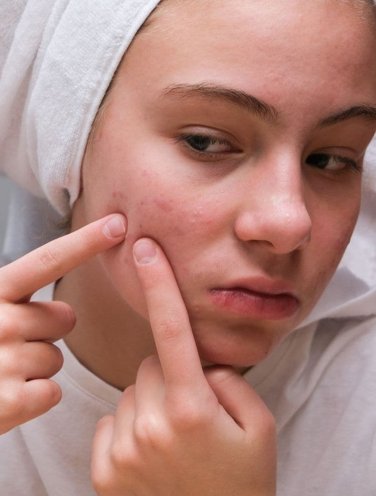4 Types Of Acne And How To Treat Them, According To Experts

What type of acne do I have? Distinguishing a papule from a pustule is not the most exciting topic, but certainly, a key one to achieving a spotless face. Acne can take several forms, and treatments require specific approaches.
We look at the 4 different types of acne. To break down the specific treatments for each type of acne, we consulted with one of America’s top physicians and CEO at Atlanta Dermatology,

1. Blackheads and Whiteheads
“Blackheads and whiteheads fall under the category of comedonal acne,” says Darren Casey, M.D. US-based Dermatologist and CEO at Atlanta Dermatology.
Whiteheads (closed comedones) are closed pores clogged with dead skin cells, dirt and excess sebum. They appear as tiny bumps, white or flesh-coloured, on the skin’s surface.
Blackheads (open comedones) are the same, except they are open. The black dots aren’t filled with dirt, so experts suggest resisting scrubbing because it will only worsen the acne.
Both are called “non-inflammatory” acne simply because they are not inflamed and don’t cause swelling.
Treatment Plan:
If pores are not properly cleaned, they can turn into pimples. Skincare experts suggest exfoliating once or twice a week. More than that will irritate your skin.
The
However, people with oily skin might benefit from the salicylic acid beads from the
2. Papules
If blackheads and whiteheads are infected by bacteria, they may become irritated and turn into another type of acne called acne papules – or inflamed comedones, a.k.a. pimples or zits.
These are tiny, hard red bumps, all caused by excess sebum, bacteria and dead skin cells.
Treatment Plan:
Casey recommends washing the face gently with warm water and a gentle cleanser twice daily and after exercise. Also, avoid makeup when exercising or sleeping. If you have dry skin, use
Experts say exercise can lead to open pores, which can become blocked by particles of makeup. Furthermore, sleeping with makeup on can clog the pores resulting in the development of acne.
Keep an acne control spot treatment like
3. Pustules
Next are the pus-filled pimples called pustules. These are the super tempting zits to squeeze – but please don’t, as this would leave permanent acne scars. This acne is similar to papules, except that pustules have a yellow- or white coloured centre.
Treatment Plan:
The American Academy of Dermatology Association recommends washing your face with cleansers that contain benzoyl peroxide or salicylic acid.
Try using a salicylic cleanser like the
“Treatment depends on the acne severity,” says
4. Cysts And Nodules
Nodular acne and cystic acne are two of the most severe forms of acne. They are both formed deep under the surface of the skin. These are large and swollen and can hurt just to the touch – they are also unsqueezable, so leave well alone.
Unlike regular pimples, these acne types tend not to form a head. Therefore, attempting to squeeze them will not release pus and may lead to further inflammation and hyperpigmentation.
Healthline describes that cystic acne can look like large, red boils, but because they’re filled with pus, cysts are softer than nodular acne.
Acne cysts develop when blackheads or whiteheads spread into surrounding areas of the skin. The body responds to this, and the local immune system produces pus. By contrast, acne nodules remain intact, deep under the skin.
Treatment Plan:
To manage smaller cysts and nodules, you can use skincare products with salicylic acid. Serum like
Why do some people get some types of acne and not others?
A study found that if both parents have acne, you’re more likely to get more severe acne early. If one or both of your parents have adult acne, you have a higher risk of getting it too.
Shop related products
ONLINE EXCLUSIVE
Precious L'Outil 3-in-1 Facial Massage Tool
unit
Luxurious, 3-in-1 facial massage tool promotes lymphatic drainage and enhances the anti-ageing efficacy of La Crème. Our luxury gua sha inspired tool is the perfect facial massager to promote lymphatic drainage and boost collagen over time. Combine with La Crème to enhance its anti-ageing efficacy.
TOP RATED
ONLINE EXCLUSIVE
Shaping Facial Lift V Facial Intensive Wrap
75 ml
Award-winning, cream-mousse face mask that relieves puffiness and swelling caused by stress, heat and hormonal changes.
